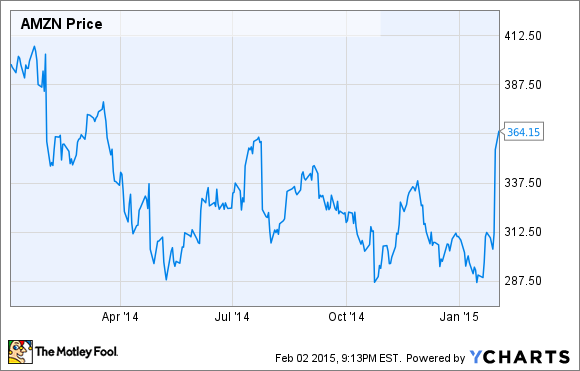Shares of e-commerce giant Amazon.com, (AMZN -1.14%) rallied 14% on Friday after the company's Q4 earnings release. The company reported EPS of $0.45, which crushed the average estimate of $0.17. While this still represented a decline from Amazon's Q4 2013 EPS of $0.51, that didn't faze investors.
To some extent, the rally in Amazon stock is making up for lost time. The stock peaked at more than $400 in early 2014 before dropping to the $300 range by the end of last year.
Amazon Stock Chart, 1/1/14-present; data by YCharts
However, the case for owning Amazon stock remains as flimsy as ever. Spending on growth initiatives continues to keep profit margins near zero. In spite of all this spending, revenue growth is slowing down, dragged down by the law of large numbers.
Revenue growth slows
In Q4, Amazon's revenue grew 15% year over year. Most companies can only dream of that level of revenue growth, but it was the slowest growth rate for Amazon since the depths of the Great Recession in mid-2009. In Q4 2013, Amazon posted 20% revenue growth.
AMZN Revenue Growth by Quarter, data by YCharts
Several headwinds held back Amazon's revenue growth last quarter. Unfavorable currency fluctuations reduced revenue growth from 18% to 15%. The launch of new game consoles in late 2013 created tougher revenue comparisons. Lastly, paid unit growth of 20% outpaced revenue growth because sales by third-party "marketplace" sellers are growing faster than Amazon's own sales.
Nevertheless, Amazon's Q4 results fit into a broader long-term trend of slowing growth. Indeed, the strong U.S. retail sales environment should have -- but didn't -- offset some of the other headwinds that Amazon faced last quarter.
The company is forecasting slower growth for Q1, as well. Revenue is expected to reach $20.9 billion-$22.9 billion: up 6%-16% year over year. That compares to growth of 23% in Q1 2014. Even without the estimated 460 basis point negative impact of foreign exchange rates, Amazon expects significant deceleration in revenue growth this quarter.
Margins remain thin
Amazon's Q4 revenue fell short of expectations -- as did its revenue guidance for Q1. Yet investors were seemingly happy to overlook this shortfall due to the company's better-than-expected earnings.
Amazon's margins remain thin, though. The Q4 earnings beat still couldn't lift Amazon into the black for the full year. Moreover, the company projected that Q1 operating income will be between a loss of $450 million and a gain of $50 million, down from a $146 million gain in Q1 2014. (Amazon's operating income guidance tends to be conservative, but even the top of the range would represent a significant decline.)
Many analysts seem to be interpreting Amazon's Q4 earnings beat and some comments made by management on the earnings call to suggest that Amazon is primed for strong margin expansion. They are likely to be disappointed. Amazon consistently trades potential profits for incremental growth by introducing new business lines, cutting prices, etc.
Diminishing returns

Amazon's Fire smartphone was a big flop. Photo: Amazon.com
This strategy has worked pretty well for Amazon in the past, but the company's recent track record is more dubious. For example, Amazon has probably invested billions of dollars to develop and market its Fire Phone smartphone and Kindle Fire tablets.
Yet the Fire Phone was a huge flop -- something that shouldn't have surprised many people. Amazon's foray into the tablet market looked promising a couple of years ago, but it too has fallen flat recently. Amazon's tablet sales plunged 70% year over year in Q4, according to market-research firm IDC.
Other growth areas like Amazon Web Services have been more successful. However, even that business segment experienced slowing revenue growth in 2014.
Amazon bulls generally argue that the company's low margins are a temporary artifact of its heavy investment in growth initiatives. But Amazon's recent trend of (roughly) breakeven results and slowing revenue growth implies that either the underlying profitability of Amazon's business is very low or its growth investments are becoming less productive.
Either way, it's bad news for Amazon investors. To justify Amazon's $170 billion market cap, the company needs to maintain a strong revenue growth rate into the indefinite future while also gradually expanding its pre-tax margin to the high single-digit range (at the very least). With each passing year, that scenario seems more and more unlikely.







